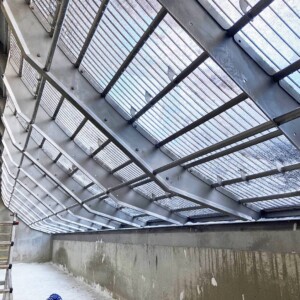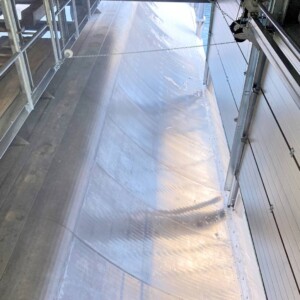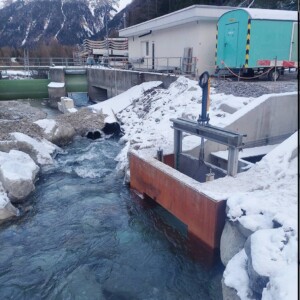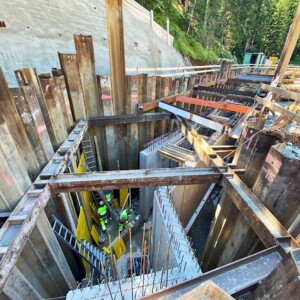Vallember weir equipped with Switzerland’s widest Coanda system to-date
The Vallember weir infrastructure is part of a multi-stage system comprehensively renovated last year by the operators Engadiner Kraftwerke AG (EKW). Built in the municipality of S-chanf and originally commissioned in 1970, to guarantee ecological continuity the weir infrastructure was enhanced to include a fish ladder and equipped with an almost completely self-cleaning „Grizzly Power Optimus“ Coanda system made by the South Tyrol-based company, Wild Metal GmbH. At a length of approximately 23m, the rake surface is made up of 20 elements, forming the broadest single Coanda screen installed in Switzerland to-date. The ‘record-breaking Coanda’ screen facilitates the discharge of up to 6,000l/s of works water, while also ensuring a safe descent for fish into the tailwater section below the weir.

Engadiner Kraftwerke AG (EKW) is one of the ten largest electricity producers in Switzerland with an average annual production of around 1,400GWh of green electricity. Major Swiss energy suppliers such as BKW, Alpiq, Axpo, CKW, the Canton of Grisons and several municipalities, are all shareholders in the partnership-oriented public limited company. EKW generates the majority of its electricity with the Ova Spin pumped storage power plant and its two storage power plants, Pradella and Martina, in the Engadine Valley, connected via gravity flow tunnels and high-pressure penstocks. The plants operate a total of 13 machine groups, including five residual water turbines, to produce a joint power capacity of 412MW. Furthermore, EKW holds a 14% stake in the cross-border Inn Joint Power Plant (GKI), which started operations in 2022.
Renovation of three water catchments
The uppermost section of the three-part plant network is the Ova Spin pumped storage power plant, whose works water is sourced from the Livignio reservoir and a total of four water catchments. The Tantermozza catchment had already been restored when comprehensive renovation work was commenced in the spring of 2020 on the other three water catchment infrastructure sites: S-chanf, Varusch and Vallember. These three water catchments are located in the municipality of S-chanf and first went online in 1970, so some parts were in urgent need of repair and replacement. The hydraulic systems controlling various regulating and shut-off valves were renewed in all the water catchments, and a number of protective screens, associated screen-cleaning machinery and items of structural infrastructure were repaired, replaced or renovated. The electrotechnical control and regulation equipment at each plant was modernised, too. “Renovation of the three water intakes had been planned for several years, but had been postponed, among other things, due to lack of personnel. Once final official approval had been granted in spring 2020, the way was clear for project implementation,” explained EKW’s project manager Curdin Barblan. In order to minimise water loss and the concomitant plant power generation reduction during the construction period, work at the three sites was staggered in three phases. Plans for the Vallember catchment along the run of the eponymous river included the renewal of structural and technical infrastructure, and the implementation of a means to ensure safe passage for fish and river-dependant life.
Minimised water loss
General renovation planning for the Vallember dam was carried out by EKW’s technical office. Straub AG, an engineering firm with a proven track record in the hydropower sector and member of the Swiss Pini Group, also played an important role in the planning process. Straub AG was charged with the analysis of the current situation, and identification of deficits prior to project implementation, and also carried out a study of options to ensure the best variant was developed for implementation by the construction management team. EKW awarded the contract for the entire construction portfolio to Costa AG, based in Pontresina, Engadine. Curdin Barblan explains: “Time limitations were a major challenge for the project as work had to be completed within a single construction season to minimise water loss. Necessary watercourse diversions were dependent on construction progress on the respective infrastructure. Rather than engineering one major watercourse diversion, a variant with three smaller diversions was chosen, and worked very well.”
Extra-wide Coanda system
The basic functional principle of extracting works water laterally was also retained after renovation of the water collection basin. Prior to reconstruction, the water passed through a coarse screen and on into a desander basin. From the desander, the water flowed over a spillway edge into a stilling basin and was channelled down a tunnel to the central S-chanf catchment weir. During reconstruction the coarse screen and spillway edge were removed, and a partition wall was erected in the middle along the length of the desander basin. Works water now flows over the partition through a Coanda rake, is collected in a trough before reaching the existing stilling basin at the end of the structure and disappearing down the tunnel. The ‘Grizzly Power Optimus’ Coanda system was supplied by the South Tyrolean industry experts at Wild Metal. The patented system is an almost completely self-cleaning protective screen for water catchments, and is suitable for use in the hydropower sector, for drinking water and for fish farms. The system takes its name from the Coanda effect, and floating debris is automatically flushed from the fine screen surface without the aid of any additional components. The entry of sand into the water intake is minimised by the extremely small screen gaps. Wild Metal relies on Inodur stainless steel to produce the Grizzly series, as it offers supreme abrasion resistance qualities. The South Tyrolians at Wild Metal supplied a total of 20 Coanda elements for the Vallember catchment, each combined with another along an approximate total width of 23m, forming the broadest Coanda system in Switzerland – and also armoured the diversion stream bodywork with 15mm Hardox steel.
Vertical-slot fish ladder
The Grizzly’s fine screen was designed to provide fish with a gap of 0.6mm through which they can descend into lower water beyond the weir, explains Curdin Barblan: “The fish pass through the partition wall in the desander and, via the screen, reach the trough to guide them safely into the tailwater below. The considerable length of the desander basin required a solution that guaranteed uninterrupted partition wall overflow. This was achieved by installing four smaller and four larger control flaps along the desander to ensure a constant water level in the headwater area, and provide the fish with a sufficiently large transition area to the Coanda system.” The flaps, which were also included in Wild Metal’s scope of delivery, optimise water intake volume instantaneously, says Curdin Barblan: “If more than 6,000l/s were taken in it would exceed the volumetric flow capacity of the penstock and cause undesired water back-up. The control flaps allow excess water to be released into the stream bed if inflows are too voluminous.” A 23-pool vertical-slot pass made of concrete elements was engineered to provide a fish ladder. After entering the tailwater area, the fish swim along a steel pipe of around 15 metres in length to the first basin below the weir. During the autumn and winter, the fish ladder is doped with a residual water discharge of 200l/s. In the spring and summer, the prescribed residual water discharge is 400l/s. Additional residual water is released through a separate pipeline into the lowest section of the fish ladder. This prevents excessive flow velocity in the tailwater, which can prove an obstacle for fish species less able to swim against strong currents.
Positive operating experience
As well as the installation of a fish passage and a Coanda system, the project also involved renovation of existing hydraulic steelwork components – such as the weir segment, flushing gate, inlet flap and bottom outlet gate. Renewal work was carried out here by the Swiss company Fäh Maschinen & Anlagenbau AG. Project implementation commenced in mid-March last year, and the renovated water intake and fish ladder were already operating in November. “Construction work involved multiple challenges, and we knew from the test drillings we were dealing with a frost depth of about 2.30m, which of course made the job all the more difficult. It took two weeks longer than estimated to install the sheet piling, with strict safety measures required during excavation. Furthermore, the original plans for the existing infrastructure were not of requisite quality. There were no design details of the lower section of the desander. Since the base element had been embedded in solid concrete, the dismantling work required to facilitate the installation of the new partition wall was extremely tough and time-consuming. A concrete block of more than 27m in length had to be extracted using rope cutting techniques. Ultimately, a challenging and fascinating project was brought to a successful conclusion,” Barblan affirmed. At present various tasks are being completed at the catchment site, including regreening and the installation of safety fencing. Monitoring the success of the fish ladder is to commence in May, and continue throughout the summer months. EKW is confident monitoring will produce positive findings. Initial operational observations have already shown that the fish ladder has been accepted by the river inhabitants.


